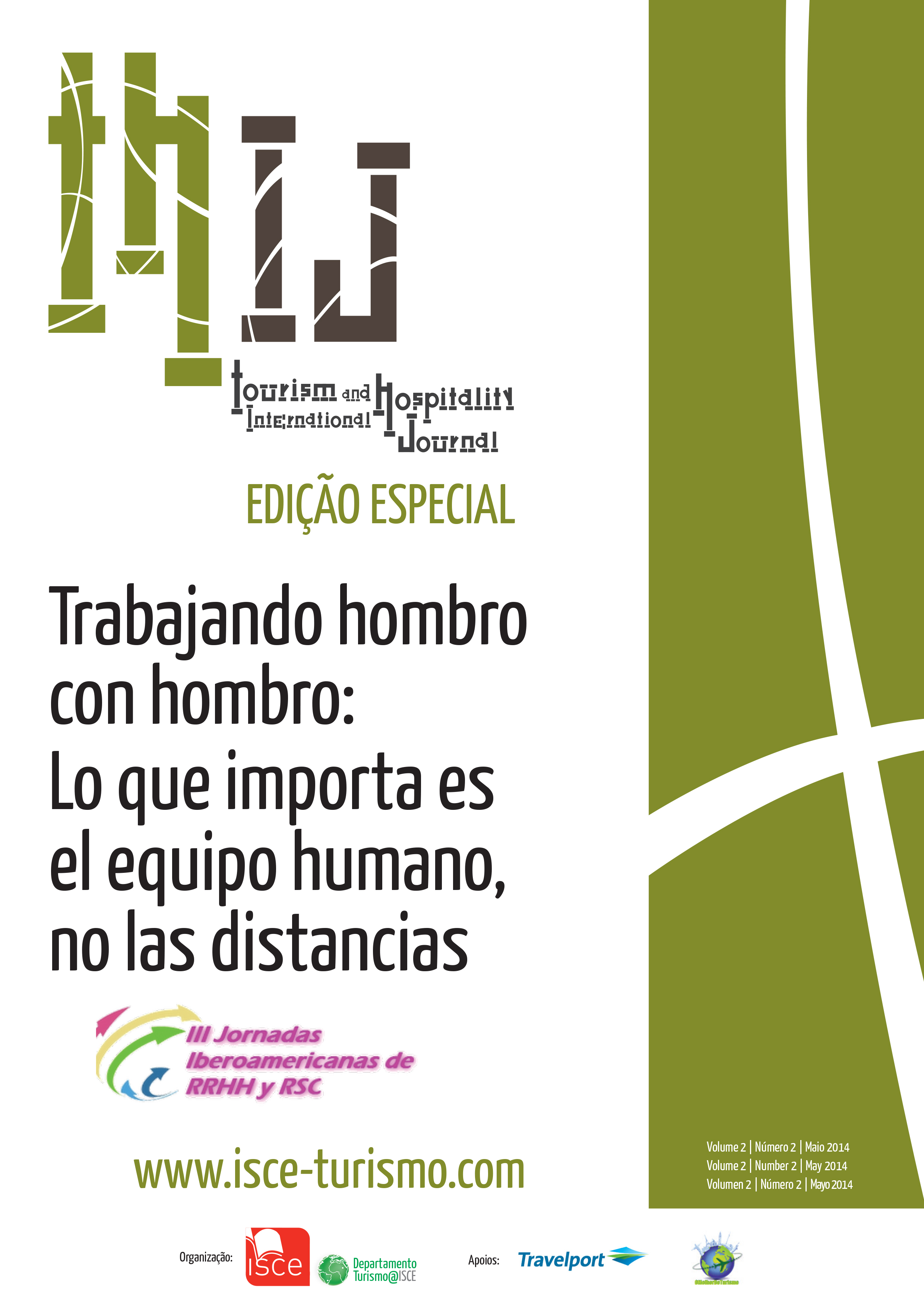Valuation of the different types of tourist offer by Ibiza's residents
DOI:
https://doi.org/10.57883/thij2(2)2014.30133Keywords:
Ibiza, Attitudes, Residents, Tourism productAbstract
Tourism depends on the good will of the residents, being fundamental the support of the local population to the development of the sector. Types and forms of tourism and, above all, the perception and the quality of tourists influence how evolving attitudes of the residents. Although a vast majority of studies of residents' attitudes discussed the tourism sector as a whole, being few cases that focus on a specific type of supply. The objective of this work is to analyze if there is tourist products with worse or better rating by Ibiza residents, through a descriptive study accompanied by a longitudinal analysis and comparison with other destinations. For the analysis were used two surveys with random sampling and personal interview. Residents consider that there is a set of very acceptable products (rural tourism and nature, nautical tourism, sports tourism, cultural tourism, congresses and fairs, sun and beach tourism, etc.), moderately acceptable products (houses for rentals and second residences) and products with problems of acceptance (golf, clubbers and all inclusive). The tourist supplies that generate less impact and involve a greater interest in the society and the local environment have greater degree of acceptance; while the tourist supply with more negative impacts and that means less interaction has low levels of acceptance.
References
Aguiló, E. & Rosselló, J. (2005). Host community perceptions. A cluster análisis. Annals of Tourism Research, 32(4), 925-941.
Allen, L. R., Long, P. T., Perdue, R. R. & Kieselbach, S. (1988). The impact of tourism development on residents' perceptions of community life. Journal of Travel Research, 27(1), 16-21.
Ap, J. (1992). Residents' perceptions on tourism impacts. Annals of Tourism Research, 19(4), 665-690.
Ap, J. & Crompton, J. L. (1998). Developing and testing a tourism impact scale. Journal of Travel Research, 37(2), 120-130.
Bigné, J. E., Font, X. & Andreu, L. (2000). Marketing de destinos turísticos. Análisis y estrategias de desarrollo. Madrid: Editorial ESIC.
Brida, G. G., Osti, L. & Barquet, A. (2010). Segmenting Resident Perceptions towards Tourism - a Cluster Analysis with a Multinomial Logit Model of a Mountain Community. International Journal of Tourism Research, 12(5), 591-602.
Bruckner, P. & Finkielkraut, A. (1979). Au Coin de la Rue. L'aventure. Paris: Èditions du Seuil.
Chías, J. (2005). El negocio de la felicidad. Desarrollo y marketing turístico de países, regiones, ciudades y lugares. Madrid: Prentice Hall-Pearson Educación.
Fredline, E. & Faulkner, B. (2000). Host community reactions: A cluster analysis. Annals of Tourism Research, 27(3), 763-784.
Gómez, L., San Martín, J. & Bertiche, C. (1999). A model of tourism experience and attitude change. Annals of Tourism Research, 26(4), 1024-1027.
Gursoy, D. & Kendall, K. W. (2006). Hosting mega events: modeling locals’ support. Annals of Tourism Research, 33(3), 603-623.
Gursoy, D. & Rutherford, D. (2004). Host atttitudes toward tourism: An Improved Structtural Model. Annals of Tourism Research, 31(3), 495-516.
Gursoy, D., Jurowski, C. & Uysal, M. (2002). Resident attitudes: a structural Modeling Approach. Annals of Tourism Research, 29(1), 79-105.
Hennig, C. (1997). Touristenbeschimpfung. Zur geschichte des anti-tourismus. Zeitschrift für Volkskunde, 93(1), 31.41.
Hibbert, C. (1974). The Grand Tour. London: Spring Books.
Jacobsen, J. K. S. (2000). Anti-tourist attitudes: mediterranean charter tourism. Annals of Tourism Research, 27(2), 284-300.
Jurowski, C. & Gursoy, D. (2004). Distance effects on residents' attitudes toward tourism. Annals of Tourism Research, 31(2), 296-312.
Jurowski, C., Uysal, M. & Williams, R. D. (1997). A theoretical analysis of host community resident reactions to tourism. Journal of Travel Research, 36(2), 3-11.
Lanquar, R. (2001). Marketing turístico: de lo global a lo local. Barcelona: Editorial Ariel.
Lee, C. K., Kim, S. S. & Kang, S. (2003). Perceptions of casino impacts: A Korean longitudinal study. Tourism Management, 24(1), 45-55.
Liu, J. C. & Var, T. (1986). Residents attitudes toward tourism impacts in Hawaii. Annals of Tourism Research, 13(2), 193-214.
Milman, A. & Pizam, A. (1988). Social impact of tourism on Central Florida. Annals of Tourism Research, 15(2), 191-204.
Murphy, P. E. (1985). Tourism: A community approach. New York: Routledge.
Pearce, D. G. (1996). Tourist organizations in Sweden. Tourism Management, 17(6), 413-424.
Pearce, P. L. (1982). Tourists and their Hosts: Some Sociological and Psychological Effects of International Contact. En Bochner, S. (edi.). Cultures in Contact. Oxford:Pergamon, 199-221.
Plog, S. C. (1974). Why destination areas rise and fall in popularity. Cornell Hotel and Restaurant Administration Quarterly, 14(4), 55-58.
Santesmases, M. (2009). DYANE Versión 4: Diseño y análisis de encuestas en investigación social y de mercados. Madrid: Ediciones Pirámide.
Scheuch, E. K. (1972). Ferien und tourismus als neue formen der freizeit. En Scheuch, E. K., & Meyersohn, R. (edi.). Soziologie der Freizeit. Köln: Kiepenheuer & Witsch, 304- 317.
Teye, V., Sirakaya, E. & Sönmez, S. F. (2002). Resident's attitudes toward tourism development. Annals of Tourism Research, 29(3), 668-688.
Urbain, J. D. (1991). L’Idiot du Voyage. Paris: Plon.
Vong, F. (2009). Changes in residents’ gambling attitudes and perceived impacts at the fifth anniversary of Macao’s gaming deregulation. Journal of Travel Research, 47(3), 388-397.
Weaver, D. B. & Lawton, L. J. (2001). Resident perceptions in the urban-rural frige. Annals of Tourism Research, 28(2), 439-458.
Williams, J. & Lawson, R. (2001). Community issues and resident opinions of tourism. Annals of Tourism Research, 28(2), 269-290.
Downloads
Published
How to Cite
Issue
Section
License
Copyright (c) 2023 This work is licensed under a Creative Commons - Attribution 4.0 International (CC BY 4.0)

This work is licensed under a Creative Commons Attribution 4.0 International License.
This work is published under the Creative Commons Attribution 4.0 International License.






